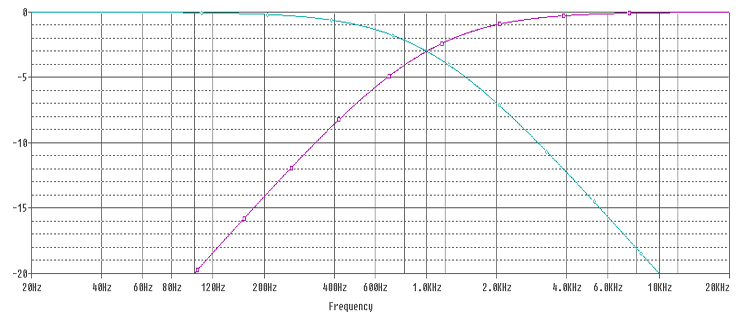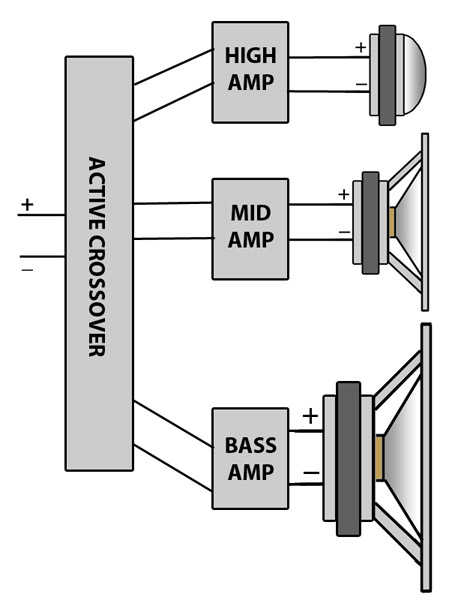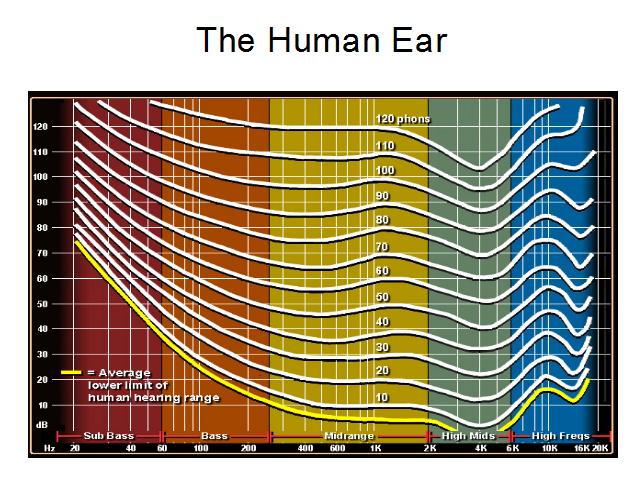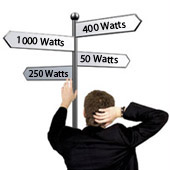With current technology, it’s impossible to have a single transducer that is able to reproduce the entire audio spectrum effectively, different types of loudspeaker driver are better suited to different speakers. Typically those handling lower frequencies are cone drivers, and commonly known as woofers. Drivers handling higher frequencies are usually much smaller, and are often known as tweeters. In many basic speakers its common to have a woofer and a tweeter in order to cover as wide a range of the audio spectrum as is possible.
A crossover is a device which splits sound/music into two or more frequency bands. In the case of a basic two-way system there would be two bands, one band covered by the woofer, and one by the tweeter.
Why can’t we just put a Woofer and Tweeter in parallel without a crossover?
Tweeters can not handle bass frequencies, lots of bass into a tweeter would destroy it. Tweeter must have high frequencies only, limited to the frequencies the tweeter is designed to handle.
In a very simple speaker, you could just use a high pass filter in series with a tweeter, in parallel with the woofer. The high pass filter would remove damaging bass frequencies and keep the tweeter operating safely.
For purposes of simplicity, all diagrams will be simplified, and a 1st order filter is assumed to be in use. A 1st order filter does not require a connection to negative (-) and can be simply put in series as per the diagram. Any filter 2nd order or higher will require a connection to negative from the filter, which will be explained in more detail in another article: https://speakerwizard.co.uk/passive-crossoversfilters-how-do-they-work/
Simple speaker with Passive High Pass Filter in series with tweeter:

HPF in the diagram is the High Pass Filter, which must be fitted in series with the Tweeter in order to protect it.
For basic speaker designs, this solution may sometimes be acceptable, but you need to be aware of the fact that below the filter frequency, the impedance of the circuit will be 8 ohms, as the amplifier will only see the woofer as the load, but at high frequencies, the amplifier will deliver power to both the woofer and the tweeter, this will present a 4 ohm load to the amplifier at higher frequencies. (8 ohm impedance of woofer and tweeter assumed in this example)
If you only intend to put one cabinet on the output of the amplifier, this wont present a problem, but if you use multiple cabinets you may find the overall impedance drops too low, which is undesirable.
Many woofers are also very inefficient at reproducing high frequencies, whilst they will readily allow power from the amplifier, they wont necessarily turn that power into anything useful, in effect wasting the power from the amplifier.
The final thing to consider is that some woofers really dont sound good outside their designed operating range, so whilst putting high frequencies signals through the woofer wont damage it, the woofer may just sound completely horrible when it tries to produce those frequencies.
The Solution?
The solution is to put a Low Pass Filter (or LPF) in series with the Woofer, this filters out high frequencies, so that the woofer is only producing sounds that are in its operating range.

The above diagram shows a passive LPF in series with the woofer, and a passive HPF in series with the tweeter.
A matched LPF and HPF that usually share the same cut-off frequency form a system known as a crossover. With a simple two-way system, crossover frequencies of between 1200 Hz and 3000 Hz are common, depending on the components used.
The cut off frequency is the point in the audio spectrum at which the filter begins to take significant effect, in the case of a Low Pass Filter, frequencies significantly below the cut-off frequency should be passing through unaffected. Just slightly below the cut-off frequency the filter begins to take effect, and starts blocking. The cut-off frequency is generally regarded as the point where the signal is at -3dB, and is in the middle of the ‘knee’ or bend in the response graph. Just above the cut-off frequency, the level begins to drop off rapidly, blocking higher frequency signals from passing. The HPF filter works the opposite way around.

By aligning the cut-off frequencies to be the same on the HPF and LPF circuits, the system impedance will stay more or less the same over the audio spectrum. Overlapping the cut-off frequencies of passive filters will cause the impedance to drop in the overlapped range. Leaving a gap between the cut-off frequencies will cause the impedance to rise in the gap.
It is possible to create more elaborate passive crossovers, such as three way crossovers that split the sound into bass, mid and treble. For smaller applications, such as hifi or studio speakers this is fairly common, but this becomes less common in high power PA speakers, as the component costs can increase significantly and in some instances it becomes difficult to source parts that can handle sufficient power
So far, we have only tackled passive crossovers..
So what is an active crossover? and whats’s the difference?
Passive crossovers do not have their own power source, all they can do is block the signal, they are regarded as passive as they can not increase it or amplify it. Passive crossovers/filters are placed between the amplifier and the speaker driver(s).
Active crossovers work quite differently. DO NOT ever fit an active crossover between the amplifier and driver, they are designed to go BEFORE the amplifier.
An active crossover will split the signal at line level, before it reaches the amplifier. The amplifier will then only amplifier the desired frequency band and deliver those frequencies to the speaker. This is a better solution, as it is more efficient – any passive crossover will have losses in it due to the components used to do the filtering. The losses amount to wasted power. Also, in cheaper crossovers, distortion can be introduced from cheaper components. Low losses and minimal distortion can be achieved with passive crossovers, but the cost of components can become astronomical, making active crossovers a better solution. There are also physical limitations with what can be achieved with passive crossovers, and as the overall system power is increased, passive crossovers become a less desirable solution.
There is a significant difference with using active crossovers, you need more amplifiers.
By splitting the signal BEFORE the amplifier, you then need a separate amplifier for each frequency band. In the case of a two-way system you will need two amplifiers, for a three-way system you will need three amplifiers.
Each amplifier will only be used to run speakers within a specific frequency band, as per the diagram below.

An active crossover also gives a much greater level of control over the system, with a typical crossover allowing boost or gain of each frequency band, and adjustable crossover frequencies. Some more advanced active crossover also allow variation of filter type (Butterworth, Linkwitz-Riley, Bessel, etc) to give precise control over the system configuration.
For large HIGH POWER systems, active crossovers are the preferred solution, with a separate amplifier for each band.
For small-medium size systems, a hybrid crossover solution is common. A 2-way active crossover is used to split bass from the mid and high frequencies, this requires one amp for Bass, and one for mid-high. The Mid-High cabinet then utilises an internal passive crossover to split between Mid and Treble. This solution is something of a compromise, it doesn’t quite give the total control of a fully active system, but it reduces the number of amplifiers needed, by not requiring a dedicated HF amplifier, and also simplifies cabling a little – eliminating the need for four core cable to run to the mid-high cabinet. This is a very common solution, as it provides a good balance of versatility and cost.

Whats best active or passive?
Its generally regarded that active crossover solutions are best, for a number of reasons:
1. Passive crossovers are always lossy, even the best passive crossovers lose some power within the crossover, primarily due to the DC resistance of the inductors.
2. Sound quality. Passive crossovers using cheaper components can often suffer from sound quality issues, to achieve better sound quality costs often escalate with passive crossovers. Generally, active crossovers offer better sound quality than passive crossovers.
3. Active crossovers allow for a more accurate predictable response, there is always some manufacturing tolerance with inductors and capacitors with variation of values of +/- 5% being common. This can often mean (more so with cheaper components) that no two passive crossovers will produce exactly the same response, so if your system comprises of numerous speakers, they could all be producing a different sound around the crossover frequency.
4. Better control. With active crossovers its much easier to balance different frequency bands. Its common with passive crossovers to require attenuation of high frequencies, through the use of attenuation resistors. With an active crossover you can just reduce the gain.
5. Easier scalability. Active crossovers make it easier to increase the size of your system, you can simply add more amplifiers and more speakers, and run them off the same signal from your crossover.















